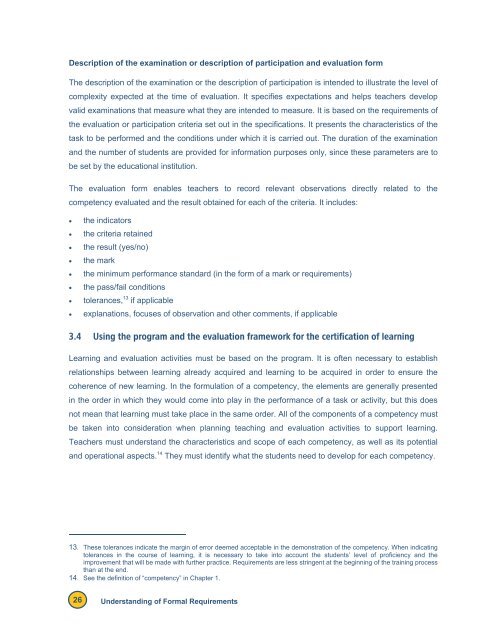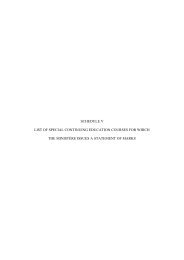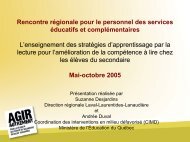Reference Framework for Planning Learning and Evaluation Activities
Reference Framework for Planning Learning and Evaluation Activities
Reference Framework for Planning Learning and Evaluation Activities
You also want an ePaper? Increase the reach of your titles
YUMPU automatically turns print PDFs into web optimized ePapers that Google loves.
Description of the examination or description of participation <strong>and</strong> evaluation <strong>for</strong>m<br />
The description of the examination or the description of participation is intended to illustrate the level of<br />
complexity expected at the time of evaluation. It specifies expectations <strong>and</strong> helps teachers develop<br />
valid examinations that measure what they are intended to measure. It is based on the requirements of<br />
the evaluation or participation criteria set out in the specifications. It presents the characteristics of the<br />
task to be per<strong>for</strong>med <strong>and</strong> the conditions under which it is carried out. The duration of the examination<br />
<strong>and</strong> the number of students are provided <strong>for</strong> in<strong>for</strong>mation purposes only, since these parameters are to<br />
be set by the educational institution.<br />
The evaluation <strong>for</strong>m enables teachers to record relevant observations directly related to the<br />
competency evaluated <strong>and</strong> the result obtained <strong>for</strong> each of the criteria. It includes:<br />
• the indicators<br />
• the criteria retained<br />
• the result (yes/no)<br />
• the mark<br />
• the minimum per<strong>for</strong>mance st<strong>and</strong>ard (in the <strong>for</strong>m of a mark or requirements)<br />
• the pass/fail conditions<br />
• tolerances, 13 if applicable<br />
• explanations, focuses of observation <strong>and</strong> other comments, if applicable<br />
3.4 Using the program <strong>and</strong> the evaluation framework <strong>for</strong> the certification of learning<br />
<strong>Learning</strong> <strong>and</strong> evaluation activities must be based on the program. It is often necessary to establish<br />
relationships between learning already acquired <strong>and</strong> learning to be acquired in order to ensure the<br />
coherence of new learning. In the <strong>for</strong>mulation of a competency, the elements are generally presented<br />
in the order in which they would come into play in the per<strong>for</strong>mance of a task or activity, but this does<br />
not mean that learning must take place in the same order. All of the components of a competency must<br />
be taken into consideration when planning teaching <strong>and</strong> evaluation activities to support learning.<br />
Teachers must underst<strong>and</strong> the characteristics <strong>and</strong> scope of each competency, as well as its potential<br />
<strong>and</strong> operational aspects. 14 They must identify what the students need to develop <strong>for</strong> each competency.<br />
13. These tolerances indicate the margin of error deemed acceptable in the demonstration of the competency. When indicating<br />
tolerances in the course of learning, it is necessary to take into account the students’ level of proficiency <strong>and</strong> the<br />
improvement that will be made with further practice. Requirements are less stringent at the beginning of the training process<br />
than at the end.<br />
14. See the definition of “competency” in Chapter 1.<br />
26 Underst<strong>and</strong>ing of Formal Requirements




